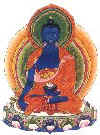|
|
||||
|
Tibetan
Medicine - Tibetan
medicine - How
Maha
Kumbh
Heritage
- Ritu
Kumar - Designing
Exhibition
|
|
|
||
|
the-south-asian.com January 2001 |
||||
|
What is Tibetan Medicine? by
Buddhist philosophy states that everything in the universe is in a constant state of flux - that all phenomenons are characterized by impermanence, and that the only permanent feature is impermanence itself. As Buddha said, "No matter whether perfect beings arise or not, it remains a fact, and a hard necessity of existence, that all creations are transitory." It is this impermanence that causes each and every being to suffer at one stage or another. Suffering is thus not accidental but springs from a specific cause, whether from this life or a previous life. Only through proper learning and the genuine practice of Dharma can liberate from the vicious cycle of suffering. Tibetan medical theory states that everything in the universe is made up of the five proto-elements sa (Earth), chu (Water), me (Fire), rLung (Wind), and Nam-mkha (Space). Although all five proto-elements are responsible for the formation of each tissue cell, each element has a specific influence: sa (Earth) exerts a greater influence over the formation of muscle cells, bones, the nose and the sense of smell; chu (Water) is responsible for the formation of blood, body fluids, tongue and the sense of taste; me (Fire) is responsible for body temperature, complexion, the eyes and the sense of sight; rLung (Wind) is responsible for breathing, skin and the sense of touch; and nam mkha (Space) is responsible for body cavities, the ears and the sense of hearing. The Three Principle Energies or Humors rLung (Wind) is one of the three principle energies of the body, which manifests the nature of Air element. It is rough, light, cold, subtle, hard and mobile. It is responsible for the physical and mental activities, respiration, expulsion of urine, faeces, fetus, menstruation, spitting, burping, speech, gives clarity to sense organs, sustains life by means of acting as a medium between mind and body. mKhris-pa basically has the nature of fire. It is oily, sharp, hot, light, fetid, purgative and has fluidity. mKhris-pa is responsible for hunger, thirst, digestion and assimilation, promotes bodily heat, gives luster to body complexion and provides courage and determination. Bad-kan is cold in nature and is oily, cool, heavy, blunt, smooth, firm and sticky. Bad-kan is responsible for firmness of the body, stability of mind, induces sleep, connects bodily joints, generates tolerance and lubricates the body. A Healthy Body gSowa rigpa (the art and science of healing or traditional Tibetan medicine, astronomy and astrology) involves the proper alignment of these divisions -- that is, the 3 humors, 7 bodily constituents and 3 excretions -- into a state of equilibrium. If this is accomplished, then the body is said to be in a state of health or free from psycho-physiological disorders; whereas a non-equilibrium in any of these energies constitutes a state of disorder or ill-health. Diagnosis in Tibetan Medicine The diagnostic techniques include visual observation, touch and interrogation. Visual Observation This involves checking a patient's skin complexion, the color and texture of his/her blood, nails, sputum, faeces, and other general conditions. Special attention is paid to the condition of the patient's tongue and urine. Touch Pulse reading forms the most important touching method employed in Tibetan medicine. Only after ensuring an important set of preconditions, the physician proceeds with a pulse diagnosis. This involves placing the three middle fingers at patient's radial arteries. Interrogation Interrogation forms the most important clinical aspect of the diagnosis. There are three main elements to a medical interrogation: * determining the causative factors * determining the site of the illness * studying the signs and symptoms: this involves the doctor asking the patient about the sort of food and drink s/he has been consuming, and what kind of physical and mental behavior s/he has been experiencing. Traditional Tibetan Medical Treatments Dietary and Lifestyle Factors At an immediate level, a disorder is primarily caused by an improper diet and/or lifestyle. In fact, a majority of health problems, both in developing and developed countries, can be either directly or indirectly traced to poor diet or lifestyle. Examples of this include alcoholism, hypertension and heart disease. The first form of treatment in Tibetan medicine is thus not medicines but changing a patient's diet and/or lifestyle. Only if this fails to remedy an ailment is the use of medicines considered. Tibetan Medicines Tibetan medicines take various forms, from decoctions, powders, general pills, precious pills, and syrups, and are prescribed in small doses -- a fact that reflects the emphasis Tibetan medicine places on gentle treatment. Moxibustion and Other Treatments Many disorders, caused by proliferation of bad blood and mKhris-pa are also treated by bloodletting at one of the body's seventy-seven bloodletting points. For cold disorders, nerve malfunction and non-malignant tumors, moxibustion, golden-needle therapy may be used to stimulate the energy channels of the body. Many diseases of the nerves and muscles, as well as pain and insomnia related to rLung, are treated with gentle massage using various medicinal oils. Medicinal bath and natural spring baths are used to treat an assortment of skin disorders as well as chronic arthritis, gout and cold types of rheumatism, and rigid and stiffness of the extremities. __________ (Courtesy Tibet Centre, Chicago) tibetcen@aol.com _________________________________ H.H. The Dalai Lama on Tibetan medicine - Tibetan medicine - How and Why it works
|
||||
| Copyright © 2000 [the-south-asian.com]. Intellectual Property. All rights reserved. | ||||
| Home |
